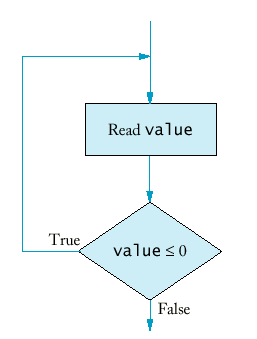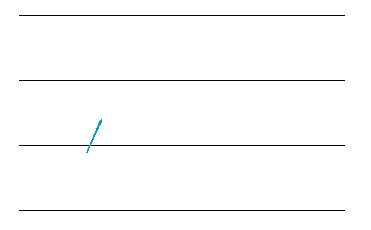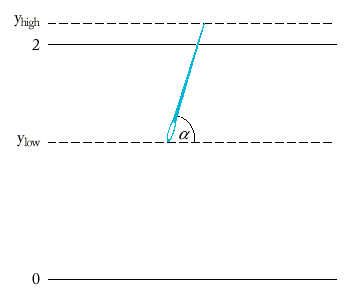| Year |
Balance |
| 0 |
$10,000 |
| 1 |
$10,500 |
| 2 |
$11,025 |
| 3 |
$11,576.25 |
| 4 |
$12,155.06 |
| 5 |
$12,762.82 |
/**
A class to monitor the growth of an investment that
accumulates interest at a fixed annual rate
*/
public class Investment
{
/**
Constructs an Investment object from a starting balance and
interest rate.
@param aBalance the starting balanece
@param aRate the interest rate in percent
*/
public Investment(double aBalance, double aRate)
{
balance = aBalance;
rate = aRate;
years = 0;
}
/**
Keeps accumulating interest until a target balance has
been reached.
@param targetBalance the desired balance
*/
public void waitForBalance(double targetBalance)
{
while (balance < targetBalance)
{
years++;
double interest = balance * rate / 100;
balance = balance + interest;
}
}
/**
Gets the current investment balance.
@return the current balance
*/
public double getBalance()
{
return balance;
}
/**
Gets the number of years this investment has accumulated
interest.
@return the number of years since the start of the investment
*/
public int getYears()
{
return years;
}
private double balance;
private double rate;
private int years;
}
/**
This program computes how long it takes for an investment
to double.
*/
public class InvestmentTest
{
public static void main(String[] args)
{
final double INITIAL_BALANCE = 10000;
final double RATE = 5;
Investment invest = new Investment(INITIAL_BALANCE, RATE);
invest.waitForBalance(2 * INITIAL_BALANCE);
int years = invest.getYears();
System.out.println("The investment doubled after "
+ years + " years");
}
}

例題:
用途:當條件滿足時重覆執行敘述 |
do
statement
while (condition);
例題: 輸入確認(Validate)
double value;
do
{
String input = JOptionPane.showInputDialog(
"Please enter a positive number");
value = Integer.parseInt(input);
}
while (input <= 0);


/**
A class to monitor the growth of an investment that
accumulates interest at a fixed annual rate
*/
public class Investment
{
/**
Constructs an Investment object from a starting balance and
interest rate.
@param aBalance the starting balanece
@param aRate the interest rate in percent
*/
public Investment(double aBalance, double aRate)
{
balance = aBalance;
rate = aRate;
years = 0;
}
/**
Keeps accumulating interest until a target balance has
been reached.
@param targetBalance the desired balance
*/
public void waitForBalance(double targetBalance)
{
while (balance < targetBalance)
{
years++;
double interest = balance * rate / 100;
balance = balance + interest;
}
}
/**
Keeps accumulating interest for a given number of years.
@param n the number of years
*/
public void waitYears(int n)
{
for (int i = 1; i <= n; i++)
{
double interest = balance * rate / 100;
balance = balance + interest;
}
years = years + n;
}
/**
Gets the current investment balance.
@return the current balance
*/
public double getBalance()
{
return balance;
}
/**
Gets the number of years this investment has accumulated
interest.
@return the number of years since the start of the investment
*/
public int getYears()
{
return years;
}
private double balance;
private double rate;
private int years;
}
/**
This program computes how much an investment grows in
a given number of years.
*/
public class InvestmentTest
{
public static void main(String[] args)
{
final double INITIAL_BALANCE = 10000;
final double RATE = 5;
final int YEARS = 20;
Investment invest = new Investment(INITIAL_BALANCE, RATE);
invest.waitYears(YEARS);
double balance = invest.getBalance();
System.out.println("The balance after " + YEARS +
" years is " + balance);
}
}
例題:
用途:To execute an initialization, then keep executing a statement and updating an expression while a condition is true |
/**
This class describes triangle objects that can be displayed
as shapes like this:
[]
[][]
[][][]
*/
public class Triangle
{
/**
Constructs a triangle.
@param aWidth the number of [] in the last row of the triangle.
*/
public Triangle(int aWidth)
{
width = aWidth;
}
/**
Computes a string representing the triangle.
@return a string consisting of [] and newline characters
*/
public String toString()
{
String r = "";
for (int i = 1; i <= width; i++)
{
// make triangle row
for (int j = 1; j <= i; j++)
r = r + "[]";
r = r + "\n";
}
return r;
}
private int width;
}
/**
This program tests the Triangle class.
*/
public class TriangleTest
{
public static void main(String[] args)
{
Triangle small = new Triangle(3);
System.out.println(small.toString());
Triangle large = new Triangle(15);
System.out.println(large.toString());
}
}
boolean done = false;
while (!done)
{
String input = read input;
if (end of input indicated)
done = true;
else
{
process input
}
}
這個模型稱為 "Loop and a half"
/**
Computes the average of a set of data values.
*/
public class DataSet
{
/**
Constructs an empty data set.
*/
public DataSet()
{
sum = 0;
count = 0;
maximum = 0;
}
/**
Adds a data value to the data set
@param x a data value
*/
public void add(double x)
{
sum = sum + x;
if (count == 0 || maximum < x) maximum = x;
count++;
}
/**
Gets the average of the added data.
@return the average or 0 if no data has been added
*/
public double getAverage()
{
if (count == 0) return 0;
else return sum / count;
}
/**
Gets the largest of the added data.
@return the maximum or 0 if no data has been added
*/
public double getMaximum()
{
return maximum;
}
private double sum;
private double maximum;
private int count;
}
import javax.swing.JOptionPane;
/**
This program computes the average and maximum of a set
of input values.
*/
public class InputTest
{
public static void main(String[] args)
{
DataSet data = new DataSet();
boolean done = false;
while (!done)
{
String input = JOptionPane.showInputDialog("Enter value, Cancel to quit");
if (input == null)
done = true;
else
{
double x = Double.parseDouble(input);
data.add(x);
}
}
System.out.println("Average = " + data.getAverage());
System.out.println("Maximum = " + data.getMaximum());
System.exit(0);
}
}
StringTokenizer tokenizer
= new StringTokenizer();
while (tokenizer.hasMoreTokens())
{
String token = tokenizer.nextToken();
process token
}
import java.util.StringTokenizer;
import javax.swing.JOptionPane;
/**
This program computes the average and maximum of a set
of input values that are entered on a single line.
*/
public class InputTest
{
public static void main(String[] args)
{
DataSet data = new DataSet();
String input = JOptionPane.showInputDialog("Enter values:");
StringTokenizer tokenizer = new StringTokenizer(input);
while (tokenizer.hasMoreTokens())
{
String token = tokenizer.nextToken();
double x = Double.parseDouble(token);
data.add(x);
}
System.out.println("Average = " + data.getAverage());
System.out.println("Maximum = " + data.getMaximum());
System.exit(0);
}
}
for (int i = 0; i < s.length(); i++)
{
char ch = s.charAt(i);
process ch
}
int vowelCount = 0;
String vowels = "aeiouy";
for (int i = 0; i < s.length(); i++)
{
char ch = s.charAt(i);
if (vowels.indexOf(ch) >= 0)
vowelCount++;
}
import java.util.Random;
/**
This class models a die that, when cast, lands on a random
face.
*/
public class Die
{
/**
Constructs a die with a given number of sides
@param s the number of sides, e.g. 6 for a normal die
*/
public Die(int s)
{
sides = s;
generator = new Random();
}
/**
Simulates a throw of the die
@return the face of the die
*/
public int cast()
{
return 1 + generator.nextInt(sides);
}
private Random generator;
private int sides;
}
/**
This program simulates casting a die ten times.
*/
public class DieTest
{
public static void main(String[] args)
{
Die d = new Die(6);
final int TRIES = 10;
for (int i = 1; i <= TRIES; i++)
{
int n = d.cast();
System.out.print(n + " ");
}
System.out.println();
}
}


import java.util.Random;
/**
This class simulates a needle in the Buffon needle experiment.
*/
public class Needle
{
/**
Constructs a needle.
*/
public Needle()
{
hits = 0;
tries = 0;
generator = new Random();
}
/**
Drops the needle on the grid of lines and
remembers whether the needle hit a line.
*/
public void drop()
{
double ylow = 2 * generator.nextDouble();
double angle = 180 * generator.nextDouble();
// compute high point of needle
double yhigh = ylow + Math.sin(Math.toRadians(angle));
if (yhigh >= 2) hits++;
tries++;
}
/**
Gets the number of times the needle hit a line.
@return the hit count
*/
public int getHits()
{
return hits;
}
/**
Gets the total number of times the needle was dropped.
@return the try count
*/
public int getTries()
{
return tries;
}
private Random generator;
private int hits;
private int tries;
}
/**
This program simulates the Buffon needle experiment
and prints the resulting approximations of pi.
*/
public class NeedleTest
{
public static void main(String[] args)
{
Needle n = new Needle();
final int TRIES1 = 10000;
final int TRIES2 = 100000;
for (int i = 1; i <= TRIES1; i++)
n.drop();
System.out.println("Tries / Hits = "
+ (double)n.getTries() / n.getHits());
for (int i = TRIES1 + 1; i <= TRIES2; i++)
n.drop();
System.out.println("Tries / Hits = "
+ (double)n.getTries() / n.getHits());
}
}